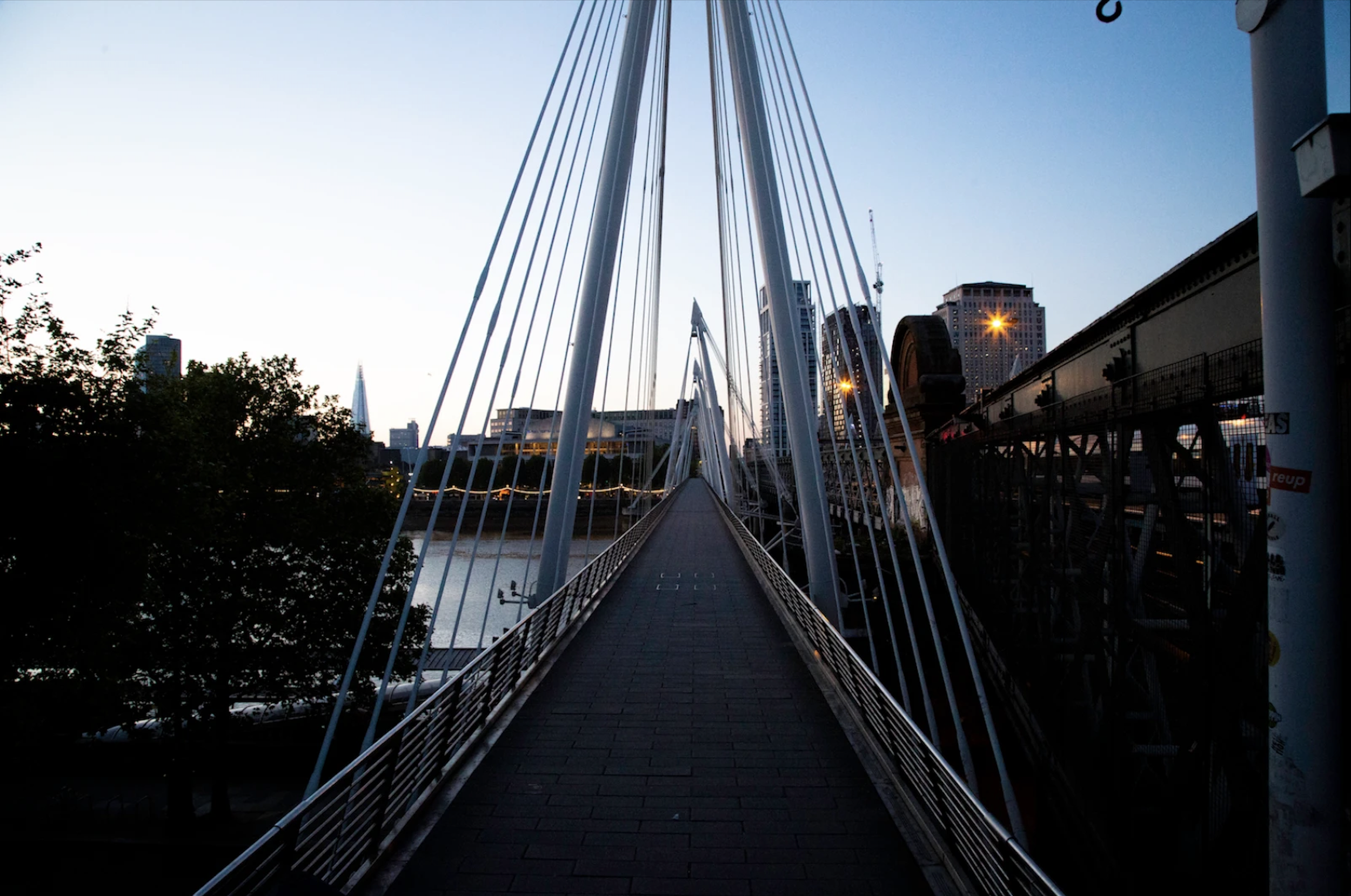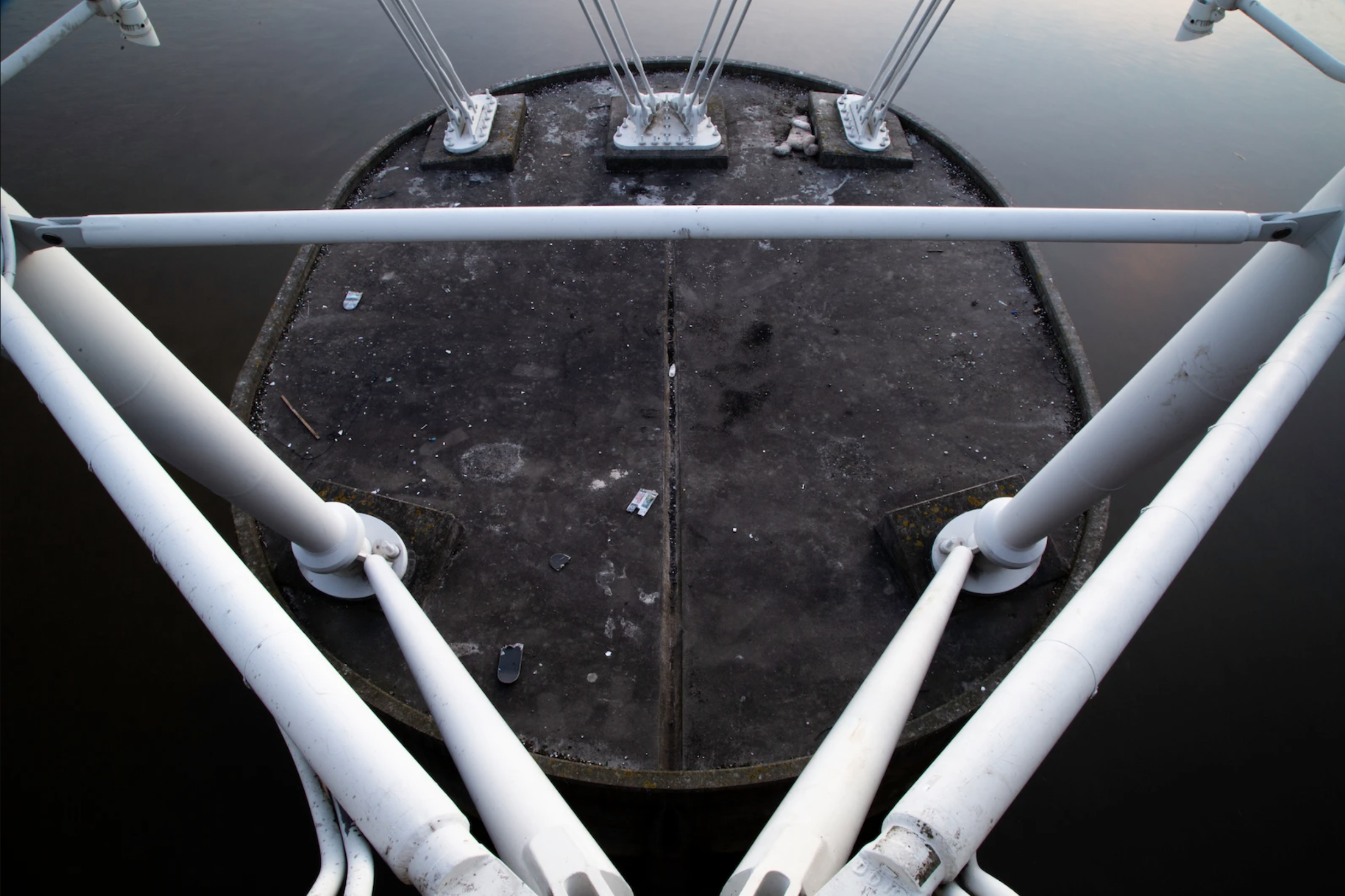The Skateboard Graveyard
All photography by Josh Eustace The Hungerford Bridge is one of the best places in London to watch the sun rise. As the glowing city night melts away and the river ceases to mirror the skyline with a long smudge of shimmering lights – in the brief moments between the last clubber shuffling home and the throngs of tourists flowing in – it's not impossible to steal a tranquil moment in one of the busiest cities in the world.
As you cross the bridge, towards the iconic graffiti-splattered Southbank Skate Space ("the world's longest continually-used skate spot", opened in 1973 in the undercroft beneath Queen Elizabeth Hall), you'll see a tribute site. For many years, a ledge above a south-side support beam has been littered with snapped skateboards. Known as The Skateboard Graveyard, the collection of used boards stands in homage to Timothy "Timo" Baxter, a 24-year-old student who was murdered on the bridge 20 years ago today.
A few skaters still practice this ritual, but it's unclear how many know the origins of the tradition – and there aren't many boards left there these days: in 2014, Westminster City Council's clean-up crew abseiled down to remove the remnants of the shrine. A move described by one skating blogger as "a massive cock-up".
Leith Penny, then Westminster's Executive Director for City Management and Communities, responded to the criticism at the time: "Unfortunately, our contractors were not aware the damaged skateboards left on one of the bridge's supports were a tribute to Timothy Baxter after his tragic death. As a result they were removed as part of an annual clean-up operation."
As the sun began to rise on the 18th of June, 1999, two old friends – Timo and Gabriel Cornish, both 24 – were enjoying the sunrise while walking home from the West End. Their night had started with Timo skating the undercroft, and ended at Break For The Border, an underground music venue off Charing Cross Road, since renamed Borderline. At around 4AM, they set off towards Waterloo station on the other side of the river. They had to cross it – but neither would make it to the other side.
Having known each other since childhood, the pair had a lot to discuss as they strolled from Tottenham Court Road down to Charing Cross. Timo had recently graduated from Manchester University with a degree in Philosophy, and had enrolled in law school. Gabriel, who had studied Sound Engineering, was embarking upon a career in the music industry.
As they approached the embankment, the pair were presented with a choice: they could opt to take the well-lit Waterloo Bridge – safer, but undoubtedly the longer route – or walk across the Hungerford Bridge, a dark, gloomy and narrow choice. After a long night of dancing, they opted for the latter so they could head to Gabriel's mum’s house to sleep. In the events that followed, Timo would lose his life and Gabriel would be lucky to escape with his.
As Timo and Gabriel began to head home, three young men – Sonni Reid, 20; John Riches, 22; and Alan West, 16 – decided to grab some drinks from an off-licence in Waterloo. They were part of a loosely-connected group of kids, largely homeless and suffering from severe social deprivation, who would invariably spend their nights roving around Leicester Square begging, getting drunk and looking for people to batter and rob.
Timo and Gabriel were in the wrong place at the wrong time; after being accosted by the trio on the bridge, they were about to become their next victims. "No money?" one of the assailants roared after the pair explained that they had nothing worth stealing. Timo's glasses were chucked into the river below, as was his skateboard. The muggers again demanded money, before threatening to hurl the two friends into the river. "Just leave us alone and let us pass," the boys responded, increasingly helpless. "We haven't got anything to give you and we don't want any trouble."
A fair fight was never on the cards, Timo was held down and simultaneously punched. Then a second group of three – Antoinette "Toni" Blankson, 17; Shaun Copeland, 14; and Cameron Sylas, 18) – walked onto the bridge from the opposite side. The victims saw this as an opportunity to escape. "I said 'help us', Gabriel told the Old Bailey during the subsequent trial. "They didn't say anything." That's when the horrifying realisation that all these people knew each other materialised. "Someone hit me over the head," Gabriel continued. "I fell. I remember being kicked in the mouth, the nose and the back of the head. I passed out."
As the pair drifted out of consciousness, what was becoming a familiar threat ominously rang out: "Let's throw them in the river. It will be fun." The pack mentality took over, and the unthinkable happened: the limp bodies of Timo and Gabriel were heaved over the four-foot rail. And dropped. They tumbled, like matchsticks knocked off a table top, into the dark River Thames 40-feet below.
Gabriel woke up in the river and found that he was clutching his backpack; it was barely keeping him afloat. He started a 30-minute battle with the strong undercurrent, and after five failed attempts at getting to the side, confusion started to settle in, along with hypothermia. He'd been swept down river nearly two miles, to Vauxhall Bridge, by the time someone on their commute raised the alarm. His life was saved by the emergency services, but Timo wasn't so lucky: he never regained consciousness. His body was found washed up 36 hours later.
Timo's mum, 76-year-old Linda Baxter, lives in West Wales. Two decades on, she does not forgive the architects of her son's untimely death. As part of her attempts to process the event, she published a book, Losing Timo, a reflective collection of prose and poems. She recalls when skating became an integral part of his daily routine. "Once the skateboard had taken over from the BMX in importance, we would have to take it on all our holidays," she told me. "After he graduated, he worked in a skateboarding shop in London. His skateboard was with him on the night of his murder. The six murderers threw him into the Thames and threw his skateboard in, too. Wretched irony."
Within a few minutes of the murder, Reid, Riches and West ambled down the embankment on the way back to Leicester Square. They came across 22-year-old student Matthew Reynolds watching the sun rise, and robbed him of his wallet and cigarette lighter. This turned out to be a mistake: he reported them to the police, as did a witness. A patrol car came and picked them up. They were taken into custody around the same time that Gabriel had been pulled out of the river.
At the time, Detective Chief Inspector Dave Shipperlee was the Senior Investigating Officer for central London. He was in charge of the ensuing murder investigation. "I remember going to Hungerford Bridge at about nine o'clock in the morning," he told me. "There was evidence of an assault, so that had been preserved as a crime scene." In a local police station, the lads were being questioned. "There was a suggestion that some other incident had happened on the bridge," he recalled. "Cornish had been found further down the river, and he'd been with a friend. We had a missing person, presumed dead."
"One of the first things we will look at is CCTV," Shipperlee says. "A camera picked up three of them walking down the escalator somewhere at Waterloo. One of the adults you can see smiling, laughing and joking. Not a care in the world – you couldn’t imagine they'd done what they'd just done." In the following weeks, while the detained suspects were remanded, hundreds of hours of CCTV was harvested and the police spent the next month looking for the remaining suspects.
By the sixth week of the manhunt, all six were in custody after what Shipperlee describes as a bit of old-fashioned policing. "We knew that a group of them had gone to [Waterloo] railway station; the trains there take you south," he said. "So we spent a lot of time on train routes leading that way. We knew that they were youngsters, so a lot of enquires were made at various schools in that direction." According to Shipperlee, none of the suspects displayed any remorse throughout the court case, and despite admitting being together they all blamed each other.
It's still not clear what happened on the bridge in the minutes before Timo died, but Judge Ann Goddard described the crime as "an act of heartless, gratuitous violence". She convicted all six of the perpetrators of murder and attempted murder, among other crimes. The adults were given life terms, while the juveniles were ordered to be detained at Her Majesty's pleasure.
§
I recently headed down to the Southbank, to ask skaters about the graveyard. Despite the fact it had been largely removed by the council, all the young people I spoke to knew about the tradition of laying the boards to rest in that spot. But none knew the origins of the practice.
An older man, wearing baggy khaki trousers and clutching a board with no trucks, gave his name as Sam. "The murder did demoralise things here," he said. "But there wasn't such a big skating community around here at the time anyway actually." He added: "The lights were turned right down, so it was really dark and gloomy; only your hardcore, die-hard skaters would skate in the dark – I don't know how we did it."
Henry Edwards-Wood – a skater, filmmaker and activist, part of the team that spearheaded the triumphant Long Live Southbank (LLS) campaign, protecting the space from redevelopment – said that as a young skater in London, part of the experience was "walking over the Hungerford Bridge and seeing the boards". He remembers when they largely disappeared. "During the campaign, someone who works on the river reassembled the boards to read LLS," he says. "At that point, someone removed it; it illustrates how the establishment will do everything to remove a message."
When contacted for comment, Councillor Tim Mitchell of Westminster City Council said: "As we approach the 20th anniversary of the tragic death of Timothy Baxter, we would like to express our full sympathies to his family and loved ones. This is a time to honour his memory and the council plans on placing a floral tribute to mark this."
It's unlikely we'll ever find out precisely what happened that night or why. But the effect it has had on others is plain to see. "We still feel grief, pain and anger," says Linda. "That doesn't go away; our love for Timo is as strong as ever – we miss him every day."
RIP Timothy Baxter 17/01/75 ~ 18/06/99


